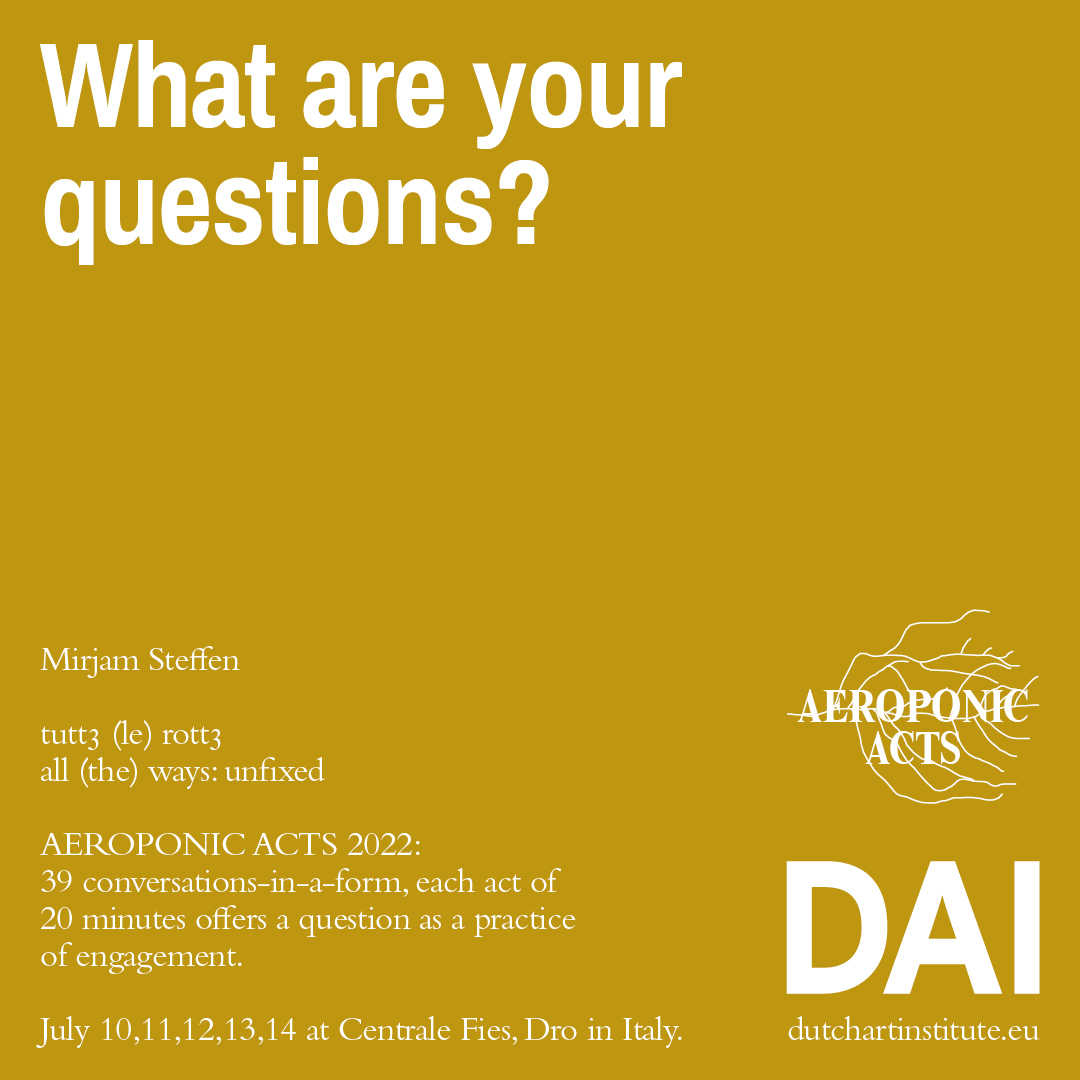Mirjam Steffen: Living the same questions
‘Aeroponic’ – root systems nourished by air – Acts is the name given to the nomadic Dutch Art Institute’s final Kitchen presentations. Each participant addresses one question, as a practice of engagement.
Here you will find the documentation of Mirjam Steffen's presentation as filmed by Baha Görkem Yalım. The written report is by Hubert Gromny and it includes a summary of the comments by esteemed guest respondents.
Living the same questions
Mirjam's question: What are your questions?
Mirjam's introduction: We life, we breath, we hope, we walk, talk, love, think, stay, leave, struggle, survive or not. I wonder how we can live together in a world where individuals have more value than the community. In a world in which we create hopes that we never want to make accessible to everyone. In a world where everything is unfairly distributed and privileges are reluctantly shared. In a world where I constantly have the feeling that someone else is deciding. How do we want to live in this world or how do we imagine the world we want to live in?
Hubert's report: The audience enters the bright space. Red tape on the floor marks rectangular shapes of different sizes. In each a number of chairs is placed together with sheets of printed text. Interruption in the red line suggests an entrance. Pre-recorded speech comes out of the speakers touching upon a variety of questions related with regard to inhabitation and living together. The text is in English and in German and is accompanied with the sounds of communal commotion, ambience of chatter is followed by a series of monologues conducted by different speakers in relay-like fashion. Meanwhile the audience finds different ways to remain in the spaces delimited with red tape—some people lie on the floor, others are sitting. The spoken text continues to speak about questions of inhabitation in regard to legality, gentrification and architecture while giving the audience simple instruction to reflect on their position within the red-lined rectangles.
Chiara Figone proposed to reflect on the method of collective reading by breaking down the idea of the individual. The idea of the individual is the founding one for systems of oppression, and for questions related with living together one needs to ask how to talk about it in a way, which dismantles the individual pragmatically within the speech. Unsettling the individual is thus an entry point to speak about excluded communities and togetherness without separability. The question here would be how to think of an individual as an actual multiple.
Momtaza Mehri connected the framing with red line and rectangular enclosures with danger-zones, which delimit spaces not to be entered. Here however there was an entry allowing the audience to choose where to sit. While taking this choice audience members had to ask themselves what temporary community to form and how to relate to each other. Momtaza noticed that within the text naming public spaces such as hospitals etc. was a recurring theme, which directed her thoughts to fetishization of a community and modalities of being forced to be part of it. The forms of cohesion are often punitive and disciplinary but can have a gentle side as well, like in spaces of refugee communities, where people network between themselves, create finance loaning schemes, initiate trusts and invite others to be part of it. Reflection on the community has thus an expansive nature. Referring to the text of the performance Momtaza commented also on the notion of hope, differentiating between individual and communal hope and pointing out how it is part of aspirational dynamics which play out within communities. Closing her response Momtaza proposed to think on spaces, which are crude and difficult—where if there is a possibility to leave it leads to another zone of retain—what happens in the spaces between one enclosure and another?
Ana Teixeira Pinto suggested rephrasing the question evoked within the presentation through individualism and situate them in specific time and place. Ana read a quote from C.B. Macpherson “The Political Theory of PossessiveI”---“The structured dimension of racial and gendered … [makes] today’s prejudice in language of individuals impossible to invoke individualism without race being implicated in the conversation”. With this quote Ana pointed out that the unresolved question of individualism crops up in places and spaces where injustice is not acknowledged as a result of a historical process. Ana mentioned also a false promise of equality exemplified often by the fact that different social groups are able to consume the same products. Referring to Sarah Ahmed’s notion of aesthetics of intolerance, Ana gave examples of how racism is legitimized in public spaces by mainstream political discourse. Ana proposed to look at the issues related with cohabitation as revolving around the question how to undo the aesthetics of intolerance.
Mirjam Steffen's "Living the same questions" was presented before live audience at the Centrale Fies, Dro, Italy on July 13th.
Find the overview of all 24 AEROPONIC ACTS 2022 here: tuttə (le) rottə - all (the) ways: unfixed


